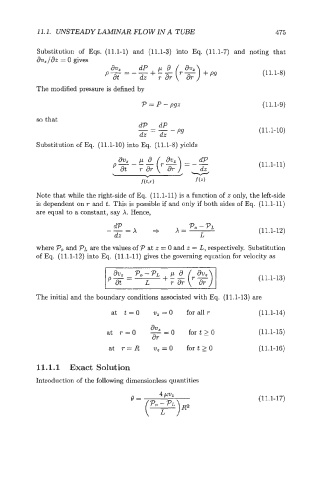Page 495 - Modelling in Transport Phenomena A Conceptual Approach
P. 495
11.1. UNSTEADY LAMINAR FLOW IN A TUBE 475
Substitution of Eqs. (11.1-1) and (11.1-3) into Eq. (11.1-7) and noting that
dv,/dz = 0 gives
dv, dP p a
Pdt=-- +;z(r%)+pg (1 1 .l-8)
dz
The modified pressure is defined by
P=P-pgz (1 1.1-9)
so that
dP
_- (1 1.1-10)
dP
--
dz dz - PS
Substitution of Eq. (11.1-10) into Eq. (11.1-8) yields
av,
a
p=-;z(r%)=-z dP
p
(1 1.1-11)
\ " 4 -
f (V) f (4
Note that while the right-side of Eq. (11.1-11) is a function of z only, the left-side
is dependent on r and t. This is possible if and only if both sides of Eq. (11.1-11)
are equal to a constant, say A. Hence,
dP -A * A= Po - PL (11 .l-12)
dz L
where Po and PL are the values of P at z = 0 and I = L, respectively. Substitution
of Eq. (11.1-12) into Eq. (11.1-11) gives the governing equation for velocity as
(1 1 .l-13)
The initial and the boundary conditions associated with Eq. (11.1-13) are
at t = 0 v, =O for all r (11.1-14)
at r=O -- - o for t 2 o (1 1 .l-15)
"2
dr
atr=R vz=O fort20 (11.1-16)
11.1.1 Exact Solution
Introduction of the following dimensionless quantities
(1 1.1-17)

